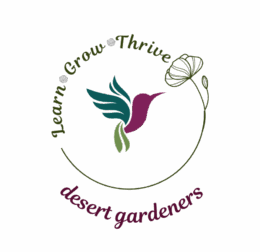Deserts and drylands have unique soil characteristics that might be unfamiliar to gardeners from other climates. Knowing more about these characteristics can help desert gardeners succeed and can help head off some of the frustrations of desert gardening.
First, let’s talk a bit about how soils are formed. Soil is a combination of the rock in a particular geographic area (known as parent material), organic matter (from both decaying and live plants and animals), water, and air. The parent material is weathered down to small particles by wind and water erosion, chemical degradation, and temperature changes (like freeze-thaw cycles). Organic matter in soil depends on the amount of plant and animal material available in that area. For example, a forest will have lots of organic material in the top layer of soil due to the dropped leaf litter and the myriad of soil organisms that are around to make use of all that free food.
Desert soils differ from the “average” soil in many ways. In more temperate and wetter areas, typical soils tend to have about 5% organic matter, but in deserts this is much lower–sometimes less than 1%. Desert soil texture is thus frequently sandy or gravelly, without much organic matter to hold moisture in.
Due to the lack of rainfall, minerals that naturally occur in parent material tend to build up in desert soils. This means that magnesium, calcium, and various other mineral salts are frequently relatively high in desert soils. This is why desert gardeners should never add minerals and nutrients to soils without first getting a soil test.
This also means that desert soils are prone to forming hard layers which can not only be a pain to dig through but can affect the way that plants absorb nutrients and can even stunt root formation. These hard layers are usually some form of calcium carbonate and are called hardpan, caliche, or calcrete. In some areas they can be 3 feet thick! This is one reason why it’s important to dig test holes in your garden BEFORE you make your desert garden design plan.
Another side effect of the buildup of salts and minerals in desert soils is that this leads to these soils being alkaline—that is, their pH is higher. This is tough for non-native plants that prefer acidic soils. Our groundwater (which is what most gardeners use to water their plants) is also alkaline and mineral rich, so even if you start out with acidic soil (like in a container) eventually the water you add will turn it alkaline. (For those who forgot their high school chemistry, here’s a great little primer on soil pH and its importance if you want more information).
On the plus side, thanks to all of those minerals, desert soils tend to be fairly productive once you add some water and organic matter, and the abundant sunshine ensures that native plants get what they need to thrive.
The big takeaway for gardeners is that if you want your plants looking their best, even native plants will usually benefit from some organic matter added to your native soil. This will help the soil keep in moisture and can help add micronutrients and balance the soil pH. There are some exceptions to the recommendation to add organic matter—cacti and agave may not like it, particularly in large amounts. But for pretty much any other plant, a small amount of additional organic matter in the soil can help them thrive.Another takeaway is that you need to get a soil test before you consider adding minerals and elements such as magnesium, sulfur, and the like. Otherwise you may be adding something that you already have lots of which is not only a waste of money but can also kill your plants. However, don’t feel that you need to get your soil tested. If you plant native and drought-tolerant plants, chances are they will tolerate your soil just fine.



